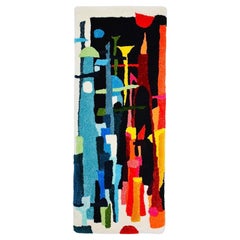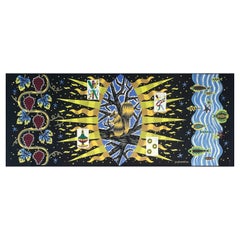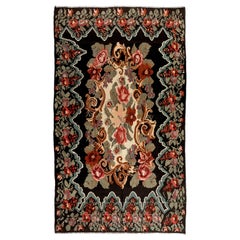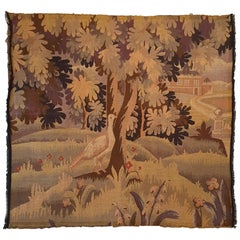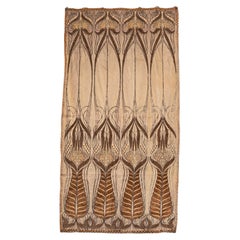Wool Tapestries
to
285
1,392
1,356
2,131
614
116
Height
to
Width
to
371
196
84
80
78
33
31
14
10
9
9
8
8
7
6
4
3
564
419
1,148
730
167
641
266
35
4
31
17
31
75
95
117
36
5
4,217
2,861
990
909
225
1,515
999
831
414
305
2,861
2,398
2,528
107
50
30
24
23
Material: Wool
SALE Handmade Mid Century Modern Evelyn Ackerman Style Textile Art Wall Hanging
Located in St.Petersburg, FL
CENTRAL AVENUE MODERN ALL TAPESTRY SALE!
Spectacular Mid Century Modern, Scandinavian, Evelyn Ackerman Style Hand Tufted, Freeform, Colorful, Wool & ...
Category
Early 2000s American Mid-Century Modern Wool Tapestries
Materials
Wool
$1,320 Sale Price
20% Off
Jean Picart Le Doux, French tapestry Atelier Pinton, 1x6, L5m00xh2m00 - No. 1437
Located in Paris, FR
Artist: Jean Picart Le Doux
Period: 20th century
Style: Modern art
Condition: Perfect condition
Material: Wool
Width: 500 cm
Height: 200 cm
A stone's throw from the Eiffel Tower We...
Category
1960s French Aubusson Vintage Wool Tapestries
Materials
Wool
$38,664 Sale Price
20% Off
6.6x11 Ft Decorative Handmade Bessarabian Kilim, Floral Rug. Vintage Tapestry
Located in Spring Valley, NY
One of a kind vintage Bessarabian Kilim.
A handwoven Eastern European Rug from Moldova. These traditional Moldovan flat-weaves are inspired from vintage Aubusson carpets but they are...
Category
20th Century Moldovan Bohemian Wool Tapestries
Materials
Wool
$1,448 Sale Price
30% Off
Beautiful Egyptian Wissa Wassef Style Hand Woven Tapestry
Located in Saint Ouen, FR
Discover a charming piece of history with this exquisite vintage Egyptian tapestry. Adorned with a delightful childish design inspired by the...
Category
Mid-20th Century Egyptian Egyptian Wool Tapestries
Materials
Wool, Cotton
807 - Tapestry of the 20th Century
Located in Paris, FR
Tapestry of the 20th century in perfect condition of conservation.
Negotiable price and free delivery.
Dimension: 92 x 92 cm.
Category
1970s French Art Deco Vintage Wool Tapestries
Materials
Wool
Art Nouveau Embroidery, early 20th C. France
Located in Istanbul, TR
A rare item to comedy, has some over all ware., some structural damages. No lining.
Category
Early 20th Century French Art Nouveau Wool Tapestries
Materials
Metallic Thread
Spanish Embroidered Gold Silver Armorial Hanging Amphora Count 70'high 55"long
Located in BUNGAY, SUFFOLK
The embroidered appliques in fine silk and gold and silver threadwork with coloured glass, sequins and mirror simulating jewels in deep relief worked onto the original red velvet tex...
Category
1640s Spanish Baroque Antique Wool Tapestries
Materials
Gold, Silver
Hera, the Fearsome Queen of Olympus, Tapestry Brussels 18th, 183Lx287H cm
Located in Paris, FR
Hera, the Fearsome Queen of Olympus, Tapestry – Brussels Manufacture, 18th Century – No. 1535
Period: 18th Century
Condition: Excellent condition
Material: Wool & silk
Width: 183 cm...
Category
18th Century Belgian French Provincial Antique Wool Tapestries
Materials
Wool, Silk
Signed Vintage Jean Picart Le Doux Tapestry with Tree Pictorial
Located in grand Lancy, CH
Signed Vintage Jean Picart Le Doux Tapestry with Tree Pictorial
Category
1970s French Vintage Wool Tapestries
Materials
Wool
Antique Embroidered Nomadic Herder’s Vest, Tibet
Located in Point Richmond, CA
Antique Embroidered Nomadic Herder’s Vest, Tibet
A rare example of a herder’s vest from west Tibet. Composed of thick natural brown Tibetan sheep’s wool, heavily embroidered with na...
Category
Early 20th Century Tibetan Tribal Wool Tapestries
Materials
Wool
Venus Visiting Vulcan, Achilles Brussels Tapestry Atelier Van Der Borcht - 1455
Located in Paris, FR
Venus Visiting Vulcan, Achilles - Brussels Tapestry, Atelier Van Der Borcht No. 1455
Artist: In the Taste of Jan Van Orley (1488 – 1541)
Period: 18th century
Style: mythological
Cond...
Category
18th Century French Antique Wool Tapestries
Materials
Wool, Silk
$70,095 Sale Price
20% Off
Vintage Tapestry Art Nouveau Abstract 5x8 Rug Aubusson 152cmx244cm Signed C.1985
Located in New York, NY
Vintage Tapestry Art Nouveau Abstract 5x8 Rug Aubusson 152cmx244cm Signed C.1985
"This is a magnificent Vintage tapestry. This Flat woven Piece h...
Category
1980s Asian Art Nouveau Vintage Wool Tapestries
Materials
Wool
Antique Flemish Verdure Tapestry 9'6 x 12'2
Located in New York, NY
Antique flemish verdure tapestry, 9'6 x 12'2. This antique Flemish tapestry, probably from Brussels is a pure verdure, no humans, just one bird and no animals disturb the sylvan tran...
Category
18th Century Dutch Antique Wool Tapestries
Materials
Wool
Bobyrug’s pretty antique French needlepoint chair cover tapestry
Located in Saint Ouen, FR
Exquisite late 19th-century French needlepoint tapestry originally from a chair cover but can be also use for cushions, or frames. Adorned with a captivating floral design from the N...
Category
Late 19th Century French Aubusson Antique Wool Tapestries
Materials
Wool, Silk
Bobyrug’s Pretty Mid Century French Needlepoint Tapestry
Located in Saint Ouen, FR
Exquisite French needlepoint tapestry featuring a stunning garden design with birds and vibrant colors. Hand-embroidered using the needlepo...
Category
Mid-20th Century French Aubusson Wool Tapestries
Materials
Wool
Late 20th Century Surrealist Carpet Inspired by Joan Miró, Femme Et Oiseaux
By Joan Miró
Located in Dallas, TX
77101, a surrealist style tapestry after Joan Miro's 'Femme et Oiseaux' Woman and Birds, 1966. The painting was the last of a series the artist comple...
Category
Late 20th Century Chinese Expressionist Wool Tapestries
Materials
Wool
Man Ray "The meeting" - French Wool Tapestry
By Man Ray
Located in New York, NY
- Handwoven wool tapestry by Atelier 3, Paris.
- Edition/6
- Project date: 1913 (from the Revolving Doors series)
- Weaving date: c. 1975
- “The Meeting" is a part of tapestry series...
Category
20th Century French Modern Wool Tapestries
Materials
Wool
Bobyrug’s Wonderful Vintage Egyptian Tapestry
Located in Saint Ouen, FR
Very beautiful mid century Egyptian tapestry probably from Wissa Wassef school, with beautiful native design and beautiful colors, entirely hand woven with wool on cotton foundation....
Category
Mid-20th Century Egyptian Tribal Wool Tapestries
Materials
Wool, Cotton
Set of Two Aubusson Door Tapestries with Blue Accents, Early 18th Century
Located in LA CIOTAT, FR
Step into a world of timeless beauty with these exquisite Aubusson tapestries ! Imagine adorning your home with these stunning door curtains that depict the enchanting seasons of Spr...
Category
Early 18th Century French Régence Antique Wool Tapestries
Materials
Wool, Silk
Tapestry Jean Lurcat "Blue Coral" Atlerie Suzanne Goubely-gatien N° 1416
By Jean Lurçat, Suzanne Goubely Atelier
Located in Paris, FR
A stone's throw from the Eiffel Tower We are a family business specializing in the purchase, sale and
expertise of old, modern and contemporary tapestries, rugs, kilims and textiles....
Category
1960s French Aubusson Vintage Wool Tapestries
Materials
Wool
A Jutland Flat Weave Mills Rug after Verner Panton
By Jutland Group, Verner Panton
Located in BROOKLYN, NY
A rare Jutland Flat Weave Mills rug or tapestry, after a design by Verner Panton. Wool, cotton and jute. In amazing preserved condition. Featuring repeating green and blue geometric ...
Category
Mid-20th Century Danish Mid-Century Modern Wool Tapestries
Materials
Wool, Jute, Cotton
Bruxella In Brabanti, Tapestry Atelier G. Chaudoir - Sun, Marce Truyens - N 1528
By G. Chaudoir
Located in Paris, FR
Bruxella In Brabanti, important Tapestry from Atelier Georges Chaudoir - Sun, Marce Truyens - N° 1528
Artist: Soleil by Marce Truyens
Era: 20th century
Style: 1950s-1960s design
Con...
Category
20th Century French Modern Wool Tapestries
Materials
Wool
17th Century Fine Flemish Tapestry, Silk & Wool, Green, Blue, Red, Battle Scene
Located in Port Washington, NY
The tapestry shown here is a magnificent example of 17th-century European artistry, likely influenced by the grand tradition of tapestry weaving that flourished in France and Flander...
Category
Mid-17th Century French French Provincial Antique Wool Tapestries
Materials
Wool, Silk
$79,199 Sale Price
20% Off
Verdure le chemin, French Greenery Tapestry by Manufacture Aubusson - N° 1514
Located in Paris, FR
Verdure Le Chemin, Tapestry from the Aubusson Factory - Signed, Bolduc - 190lx110h - No. 1514
Weaver: Manufacture Aubusson
Era: 19th century
Style: Greenery
Condition: Perfect condi...
Category
19th Century French French Provincial Antique Wool Tapestries
Materials
Wool, Silk
Large tapestry
Located in Isle Sur Sorgue, FR
Very large tapestry made of different textiles (wool, cotton..)
Very decorative piece resulting of the use of different techniques of embroidery.
Rare piece in great condition.
Category
21st Century and Contemporary Spanish Wool Tapestries
Materials
Wool, Cotton
$5,218
Antique 16th Century Brussels Baroque Mythological Tapestry with Angel
Located in New York, NY
Tapestries were ubiquitous in the castles and churches of the late medieval and Renaissance eras. At a practical level, they provided a form of insulation and decoration that could b...
Category
16th Century Belgian Baroque Antique Wool Tapestries
Materials
Tapestry, Wool
Antique 18th Century Flemish Mythological Tapestry, with the Greek Deity Apollo
Located in New York, NY
An antique 18th century Flemish mythological tapestry, size 11'0 H x 12'6 W. This period European tapestry depicts the Greek God Apollo, who is the deity of the arts, poetry, crops, ...
Category
18th Century Belgian Antique Wool Tapestries
Materials
Wool, Silk
$25,996 Sale Price
20% Off
Antique Indian Handmade Paisley Textile Shawl with Brilliant Colors
Located in Atlanta, GA
Antique Indian Handmade Paisley Textile Shawl in Red and Brilliant Border.
19th Century Antique Indian Hand made Paisley Textile Shawl with Brilliant...
Category
Early 1900s Indian Tribal Antique Wool Tapestries
Materials
Wool
Pretty vintage French jacquard tapestry Aubusson style « ferryman »
Located in Saint Ouen, FR
Discover the exquisite charm of this mid 20th-century French tapestry, meticulously woven on Jacquard looms in French workshops. Crafted from a blend of cotton and wool it captures a...
Category
1970s French Aubusson Vintage Wool Tapestries
Materials
Wool, Cotton
Bobyrug’s Wonderful Vintage Egyptian Vintage Tapestry
Located in Saint Ouen, FR
Very beautiful mid century Egyptian tapestry probably from Wissa Wassef school, with beautiful native design and beautiful colors, entirely hand wove...
Category
Mid-20th Century Egyptian Tribal Wool Tapestries
Materials
Wool, Cotton
16th Century Antique Brussels Tapesty 7'6" X 6'
Located in Los Angeles, US
A wall hanging tapestry, simply put, is a textile specifically designed and woven to portray an artistic scene with the intent of hanging it on a wall. Antique tapestries, those that...
Category
16th Century Unknown Other Antique Wool Tapestries
Materials
Wool, Cotton
Late 16th Century Brussels Historical Tapestry with the Roman General Scipio
Located in New York, NY
A Brussels historical tapestry, attributed to Martin Reymbouts, late 16th century. From the story of Scipio series, the renowned Roman general, a royal c...
Category
16th Century Belgian Antique Wool Tapestries
Materials
Wool
$199,995 Sale Price
33% Off
17th Century Brussels Tapestry 8'4" X 6'4"
Located in Los Angeles, US
A wall hanging tapestry, simply put, is a textile specifically designed and woven to portray an artistic scene with the intent of hanging it on a wall. Antique tapestries, those that...
Category
17th Century Unknown Other Antique Wool Tapestries
Materials
Wool, Cotton
17th Century Flanders Biblical Tapestry life of Moses ( 10' x 12'8"-305 x 385 )
Located in New York, NY
17th Century Flanders Biblical Tapestry ( 10' x 12'8" - 305 x 385 )
Subject: Scene from a life of Moses Series, probably the reconciliation of Miriam and Zipporah
Period: Late 16th ...
Category
Early 17th Century Belgian Antique Wool Tapestries
Materials
Wool
Aubusson Tapestry from 19th Century - N° 1240
Located in Paris, FR
a very prettyAubusson tapestry of 19th century with red and blue and white colors, a temple and rivers in very good condition- N° 1240
Thanks to our Restoration-Conservation works...
Category
1880s French Aubusson Antique Wool Tapestries
Materials
Wool
Jean-Claude Bissery - Dawn, sun & bird - Huge Wool Tapestry, France Circa 1960
Located in leucate, FR
A striking and vibrant wall tapestry titled "Aurore", designed by French artist Jean Claude Bissery, under the direction of Dermagne – Éditeur d’Art, and published by the prestigious...
Category
1960s French Vintage Wool Tapestries
Materials
Wool
18th Century French Pastoral Landscape Tapestry, with Shepherds and Their Sheep
Located in New York, NY
A French pastoral landscape tapestry from the 18th century, envisioning a placid scene in which a shepherd and shepherdess repose under a large tree with three of their sheep within ...
Category
18th Century French Antique Wool Tapestries
Materials
Wool
$2,995 Sale Price
25% Off
Original Elie Grekoff Tapestry Zodiac Cancer Wool Paris Proof of Authenticity
By Elie Grekoff
Located in Miami, FL
Signed Zodiac Grekoff handwoven tapestry in wool & cotton, titled Cancer.
Marked at the Front right corner and proof of authenticity on the reverse.
Category
1960s French Mid-Century Modern Vintage Wool Tapestries
Materials
Wool, Cotton
Pretty Vintage Polish Woven Tapestry by E. Oloksy
Located in Saint Ouen, FR
Wonderful mid century polish tapestry with a native design of town and beautiful light colors, entirely hand woven with wool on cotton foundation
Name...
Category
Mid-20th Century Polish Scandinavian Modern Wool Tapestries
Materials
Wool
Nice French Aubusson Style Medieval Design jacquard Tapestry
Located in Saint Ouen, FR
Behold this exquisite French tapestry, meticulously crafted as a museum-tapestry design replica. This tapestry captures the essence of a renowned masterpiece, featuring a captivating...
Category
Mid-20th Century French Medieval Wool Tapestries
Materials
Wool, Cotton
Contemporary Handwoven Wool Rug Red and Grey Toned Kilim or Tapestry
By Andrew Boos
Located in Brooklyn, NY
Inspired by the physics of light. The shifting tones and negative space echo the spectrum of light emitted from an object as it moves away from us in space.
The asymmetrical design...
Category
21st Century and Contemporary American Modern Wool Tapestries
Materials
Wool, Cotton
Aubusson French handmade tapestry made of wool and cotton.
Located in Firenze, FI
This 310 cm. x 210 cm. large tapestry originates from Aubusson in France, known for their fine quality and detailed designs
A castle in the background and a hunting scene in the fore...
Category
1950s French Vintage Wool Tapestries
Materials
Wool, Cotton
Textile Poster, Contemporary Handwoven Tapestry by Andrew Boos
By Andrew Boos
Located in Brooklyn, NY
This wall hanging is a one of a kind heirloom piece, inspired byFrank Lloyd Wright and the Prairie School architects, and Joseph Albers studies on colors.
The entire process of cre...
Category
21st Century and Contemporary American Modern Wool Tapestries
Materials
Wool, Cotton
Orange Fish, Elie Grekoff - French Tapestry By Atelier Pintons Frers - No. 1469
Located in Paris, FR
Artist: Elie Grekoff
Period: 20th century
Style: Design 50's and 60's
Condition: Perfect condition
Material: Wool
Width: 242 cm
Height: 148 cm
Depth: 0.5 cm
Marine theme: The centra...
Category
20th Century French Aubusson Wool Tapestries
Materials
Wool
Rare Tunisian Ouedzem Embroidered from Private Collection
Located in Alessandria, Piemonte
Rare and vintage Tunisian carpet, embroidered like a tissue for wall - Private Italian collection -
IDEA: use this item as tapestry on the wall or on ...
Category
1960s Tunisian Tribal Vintage Wool Tapestries
Materials
Wool
1820's Antique French Aubusson Tapestry with Venus and Adonis, 07'00 x 14'06
Located in Dallas, TX
77237 Antique French Aubusson Tapestry with Venus and Adonis, 07'00 x 14'06. This magnificent handwoven wool and silk antique French Aubusson tapestry exudes the grandeur and elegance of the Early 19th Century, drawing inspiration from the works of Italian Baroque painter Francesco Albani...
Category
Early 19th Century French Louis XIV Antique Wool Tapestries
Materials
Wool, Silk
Antique 19th Century Ivory Ornate Floral French Aubusson Tapestry
Located in New York, NY
This is a lovely antique 19th century ivory ornate floral French Aubusson tapestry. It has floral garlands and an oval window looking onto a scene with a woman presenting a dove to a...
Category
19th Century French Aubusson Antique Wool Tapestries
Materials
Tapestry, Wool
Bobyrug’s Pretty Vintage Egyptian Tapestry
Located in Saint Ouen, FR
Exquisite midcentury Egyptian tapestry, inspired by the Ramsès Wissa Wassef School Tapestries. Featuring a stunning nature-themed design with animals, birds, and fish, adorned with v...
Category
Mid-20th Century Egyptian Aubusson Wool Tapestries
Materials
Wool, Cotton
17th Century Antique Flemish Tapestry 6'8" X 3'3"
Located in Los Angeles, US
A wall hanging tapestry, simply put, is a textile specifically designed and woven to portray an artistic scene with the intent of hanging it on a wall. Antique tapestries, those that...
Category
17th Century Unknown Other Antique Wool Tapestries
Materials
Wool, Cotton
Antique french Needlepoint Panel or border Tapestry
Located in Saint Ouen, FR
Beautiful late 19th century needlepoint tapestry in the form of a stripe or border fragment, with nice floral design and beautiful colours, entirely hand embroidered with needlepoint...
Category
Late 19th Century French Aubusson Antique Wool Tapestries
Materials
Wool, Silk
Gold/Orange Handwoven Tapestry by Calyah
Located in Geneve, CH
Gold/Orange handwoven tapestry by Calyah
Unique piece
Materials: Tibetan wool and silk.
Dimensions: 170 x 65 x 1 cm
Colour: gold/orange.
Also available in red/yellow, white/blue...
Category
2010s Nepalese Post-Modern Wool Tapestries
Materials
Wool, Silk
$2,870 / item
Robert Motherwell "Blue and Green" Tapestry
Located in West Palm Beach, FL
Robert Motherwell Blue and Green Tapestry
The Textile was commissioned by Modern Masters Tapestry, inc.
Originally woven in 1965
A neutral beige backgr...
Category
1960s American Vintage Wool Tapestries
Materials
Wool
Aubusson Tapestry, Berger Mouton, xix E. Century, N° 1149
Located in Paris, FR
Aubusson tapestry - Berger Mouton - XIX E. century mille fleures gothic.
Thanks to our Restoration-Conservation workshop and also Our know-how,
we are pleased to present to you wo...
Category
1880s French Aubusson Antique Wool Tapestries
Materials
Wool
Vintage Embroidered Picture "Beautiful Rose" in a Golden Frame
Located in Bussiere Dunoise, Nouvel Aquitaine
French Vintage Embroidered Picture "Beautiful Rose" in a Golden Frame from the Mid-Century.
This lovely artwork features a stunning hand-embroidered rose motif in soft colors, set w...
Category
1950s French Folk Art Vintage Wool Tapestries
Materials
Metal
$154 Sale Price
35% Off
Pierre Adrien Chabal, Louis XVI Style Beauvais Tapestry Panel, France, C.1855
Located in Chatham, ON
PIERRE ADRIEN CHABAL-DUSSURGEY (1819-1902) Designer - BEAUVAIS TAPESTRY MANUFACTORY Maker - Important Antique Louis XVI style floral tapestry chair back - the floral tapestry finely woven in wool and silk threads with garlands and swags and tassels - all centered by a powder blue ground cartouche with white roses within an oval frame - suitable for framing - France - circa 1855.
Excellent antique condition - minor fading and loss - areas of wear/thinning - no apparent restoration - minor stains and soiling with signs of age and use.
Size/Dimensions - 20" (51 cm.) Wide x 19 1/2" (49.5 cm.) High.
PIERRE ADRIEN CHABAL-DUSSURGEY - born Pierre Adrien Chabal in 1819 in Charlieu and adopting the professional name of CHABAL-DUSSURGEY - well known for his paintings and studies of flowers in gouache and oils - attended the School of Fine Arts in Lyon - exhibited at the Paris and Lyon salons - he worked with the Gobelins Tapestry Manufactory and the Beauvais Tapestry Manufactory after 1849 designing tapestries, rugs and tapestry covers for seating - he designed tapestries for the Élysée Palace and worked with Empress Eugenie on furnishings for the small salon at the Élysée Palace and two salons in the palace of the Empress in Biarritz - tapestry covered furniture...
Category
Mid-19th Century French Louis XVI Antique Wool Tapestries
Materials
Wool, Silk
1950's Persian Shiraz Pictorial Carpet with Traditional Style
Located in Dallas, TX
79097 Vintage Persian Shiraz Pictorial Rug, 03'10 x 06'04. This extraordinary hand-knotted wool vintage Persian Shiraz rug presents a captivating pictorial narrative, vividly depicti...
Category
Mid-20th Century Persian Aesthetic Movement Wool Tapestries
Materials
Wool
Post Modern "Sunhooks" Abstract Wool Tapestry Wall Art
Located in Los Angeles, CA
Post Modern "Sunhooks" Abstract Wool Tapestry Wall Art
Category
1980s American Mid-Century Modern Vintage Wool Tapestries
Materials
Wool
Vintage Persian Shiraz Pictorial Rug, Wall Hanging, Persian Tapestry
Located in Dallas, TX
75045 Vintage Persian Shiraz Pictorial Rug, 03’08 x 05’02. Persian Shiraz pictorial rugs are a distinctive type of Persian rug crafted in the region surrounding the city of Shiraz in...
Category
Late 20th Century Persian Modern Wool Tapestries
Materials
Wool
Aubusson Tapestry by Jean Lurcat - hand woven and signed - titled " AQUARIUS"
By Jean Lurçat
Located in Greenwich, CT
Jean LURÇAT (1892-1966)
‘Le Verseau or Aquarius’ from the series 'Les signes du Zodiaque'
Hand woven wool Tapestry in Aubusson at Ateliers Picaud, 1960’s
dimensions: 28 x38 inches
...
Category
1960s French Modern Vintage Wool Tapestries
Materials
Wool
Tibetan Dragon Rug Pure Wool Hand Knotted, Asymmetrical Tapestry, 1970s
Located in Andernach, DE
Tibetan hand knotted wool rug or tapestry, this shape reminds of a saddle bag cover.
Very decorative pure wool thick pile with asymmetrical cotton fringes.
Rare item, likely custom m...
Category
Mid-20th Century Tibetan Art Deco Wool Tapestries
Materials
Wool
Recently Viewed
View AllMore Ways To Browse
Mirror 1953
Mobelfabrik Bed
Modern Tansu
Moet Champagne
Moon Pot
Moreau Cherubs
Moroccan Flask
Moroccan Leather Boxes
Moroccan Tile Table
Moser Purple
Mother Of Pearl Caviar Spoons
Mother Of Pearl Dresser
Mother Of Pearl Dressing Table
Murano Glass Walter Furlan
Murano Harlequin
Murano Pink Swan
Nathaniel Mills Vinaigrettes
Nautical Hooks
